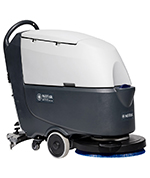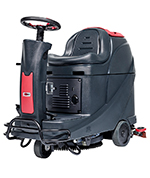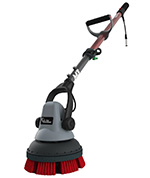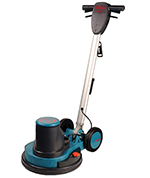Floor Scrubbers & Scrubber Dryers
A wide selection of pedestrian and ride-on floor scrubbers / scrubber dryers
Leading brand floor scrubbers and scrubber dryers, from compact designs for cleaning awkward areas, to larger ride-on floor scrubbers for cleaning industrial and retail areas. Battery powered floor scrubbers are becoming more popular, in view of the lack of trailing cables and low noise levels.
We also feature single disc rotary floor cleaners for hard floor scrubbing and polishing, and portable, compact floor scrubbers which can also be used to clean walls and other surfaces.
Floor scrubbing machines – built for commercial use
All floor scrubbers / scrubber dryers are robustly constructed and have large solution capacity to ensure longer cleaning time, whilst being easy to operate, reducing fatigue and ensuring efficient cleaning. For an explanation of some of the terms used on our products please see our how to choose guide.
Did you know that for one-off cleaning jobs or occasional floor scrubbing, you can hire a scrubber dryer from B&G?
Please click on the links below to view our range of floor scrubber dryers
-

Pedestrian Floor Scrubbers & Scrubber Dryers
-

Ride on Floor Scrubbers & Scrubber Dryers
-

Portable Scrubbers
-

Floor Buffers, Floor Polishers and Rotary Scrubbers
Floor Scrubbers / Scrubber Driers – How to Choose
The floor scrubber, or scrubber drier is an important tool in the housekeeping regime for many industrial and commercial premises.
Floor scrubbers use mechanically driven brushes which act on the floor’s surface to remove dirt, usually with the aid of cleaning chemicals. In a traditional style commercial floor scrubber, the cleaning solution is dispensed from a tank on the machine. The residue is then collected by a system of squeegees and ultimately deposited into a collection tank for later disposal. At the end of this process you should be left with a clean and dry floor.
There are choices to be made in selecting the right scrubbing machine. For example brushes – a cylindrical brush is better for a polishing effect and de-greasing recessed floors and a disc brush is ideal for persistent or adherent dirt.
Types of Equipment
There are two main types of floor scrubbing machine, one pushed along manually by an operator and known as a walk-behind or pedestrian operated floor scrubber.
The other type is a ride-on scrubber drier where the operator drives the machine around the floor to carry out the cleaning.
The level of sophistication of both types of machine varies and it is important to select one that suits its purpose.
Also becoming more popular are portable scrubbers for floors and walls, which are lightweight, easy to manoeuvre and can also be used to clean walls and other surfaces, not just floors. The MotorScrubber M3 for example is powered by a battery backpack and the handheld scrubber weighs only 1.5Kg. With a telescopic handle which can extend up to 2.4 metres, this scrubber is ideal for use in areas like changing rooms. It’s also waterproof, so can be used in and around swimming pools and other wet areas.
Selecting the right machine
For instance, not all scrubbing machines have a vacuum recovery system and rely on the squeegees alone to mop up the residue, which, in small areas requiring a lighter duty, may be adequate. Perhaps the most important part of a scrubber drier is an efficient brush system as without that the dirt cannot be effectively lifted from the floor. Many machines on the market today have self levelling brushes or brush pressure adjustment capabilities to ensure that they can cope when the floor is not level which is often the case in industrial environments.
Scrubber driers are powered by either electric cable, or by chargeable battery pack. So the first consideration is about the proximity of a power supply – will there be one within reach of the area you want to clean – e.g. 15 metres? If there is a power supply, could trailing cables cause a hazard, e.g. in public areas? If so, it might be better to use a battery powered floor scrubber. Battery powered scrubbing machines are becoming very popular and advances in battery technology mean that they can be used for quite long periods of time without re-charging. It’s just a matter of calculating the floor area and productivity rate, then you can make sure you have a machine with long-enough battery life for your needs.
The size of the solution and recovery tanks should also be considered to ensure there is enough capacity to clean the required floor area. Where scrubber dryers are used in an industrial workplace they can come in for rough treatment, so the body of the unit should be durable and resilient to the possible hard knocks that may come its way.
The selection of the right floor scrubber drier doesn’t have to be a problem, contact our floor cleaning machine experts for advice.
Terminology – what it all means
Listed below are some explanations of the types of terminology used by manufacturers and why they are relevant in making your choice.
Dimensions
The physical size of the dryer. The cleaning width denotes the cleaning area, however the physical size of the machine also needs to be taken into account as it may have to fit through doorways or other smaller spaces. There may also be limited storage space.
Cleaning / Working Width
The effective width of floor cleaned. The cleaning width is determined by the size and placement of the cleaning brush, pad or roller and is different from the machine width. This is relevant for estimating how long it would take to clean a floor (along with the machine speed for ride-on machines). The dimensions of the area being cleaned are also relevant here, particularly if there are any small gaps or passageways which the machine needs to pass through.
Floor Scrubber Squeegee Width
When a floor is cleaned the residue is collected by squeegees at the back of the machine and vacuumed into the recovery tank. The squeegees collect the dirty water at the rear of the machine which is then vacuumed into the waste tank. The squeegee is wider than the machine body and is a vital part of the effective operation of the machine. An ineffective squeegee will leave dirty water behind, so the squeegee width is important to know, as the wider it is, the more area can be covered, but it it’s too wide to fit into areas you need to clean, it won’t be effective.
Vacuum Power
The suction power of the machine. The vacuum power is important, as the water needs to be removed from the floor surface. A weaker vacuum may mean not being able to clean in a single pass.
Scrubber Dryer Tank Capacity
The capacity of the solution tank and recovery (waste) tank. The capacity of the tanks is a factor determining how long the scrubber can work before refilling/emptying. Tank capacities can range from 4 litres to over 150 litres.
Brush / Pad Options for Floor Scrubbers
The options to choose from, depending on scrubber dryer use. Scrubber dryers will use either a cylindrical or roller brush or a disc pad. Selection depends on the type of floor surface, how level the surface is and the nature of the soiling to decide which method gives the best results.
Scrubber driers with a disc type cleaning method usually have a lower initial cost (although not on all models), are simpler to maintain and replacement disc brushes are less expensive to replace than cylindrical brushes.
Cylindrical type scrubber driers keeps less bristle surface contact with the floor than disc brushes and also rotate up to 3-times faster. Most cylindrical models, particularly the larger versions also have the benefit of a debris tray mounted behind the brushes to collect small debris from the surface and eliminate the need for a pre-sweep prior to cleaning and reduce the potential of blockages in the squeegee area, giving better productivity.
Brush Pressure
The pressure the cleaning brush exerts on the floor. Brush pressure is an indicator of cleaning efficiency, particularly on uneven floors.
Brush Speed
The speed at which the brush rotates. The brush agitates the detergent into the floor surface. A faster speed means more effective scouring.
Traction
Machine with motive power. Pedestrian or walk-behind floor scrubbers may be supplied with a traction drive to aid moving the dryer. For smaller machines it is not really practical as having this extra does add to the cost. Larger machines with bigger solution and waste tank need some additional motive power to reduce operator fatigue and increase the machine’s manoeuvrability in tight areas.
Max Area Performance
The area that can be cleaned, normally expressed as square metres per hour. This is particularly relevant if you have a large floor area to clean and only a set amount of time to complete the job.
Machine Weight
The total weight of the floor scrubber, normally in Kg. The weight is a consideration for the operator. It is also important to consider the design of the machine making sure that the machine is designed to make the weight manageable. If a machine is too light it may tip over or turn too easily.
Power Source
Battery or mains powered. Mains powered floor scrubbers / scrubber dryers have an advantage over battery operated dryers in that they can be used at any time and used for as long as needed. The downside is that, in larger areas the cable can get in the way of the cleaning process, slowing it down, as well as causing a potential trip hazard.
A battery operated machine can clean much quicker, however the cleaning time is limited by the battery size. A battery powered scrubber dryer will need to be charged before use and potentially needs more maintenance to ensure maximum use from the batteries.
Sound Level
The noise the scrubber dryer makes in operation. This is particularly important if the machine is to be used when other operatives or the public are present, normally the acceptable level is 63dBA. There are some extremely quiet floor scrubbers available now, particularlly the battery powered machines.
Hiring a floor scrubber
Choosing a scrubber dryer is a big decision as efficient floor cleaning is an important part of any cleaning regime in industrial or commercial premises. The type and size of floor, the motive power, as well as the type of dirt being removed influences the choice of machine. For regular use, it makes sense to buy your own machine, but for occasional use or to try one out, why not hire?
We have a range of scrubber dryers for hire at competitive prices.
Need advice? See our information sheet which explains the terminology used to describe scrubber driers.
Or give us a call and one of our scrubber drier experts will be happy to help.
Or see floor scrubbers for hire


